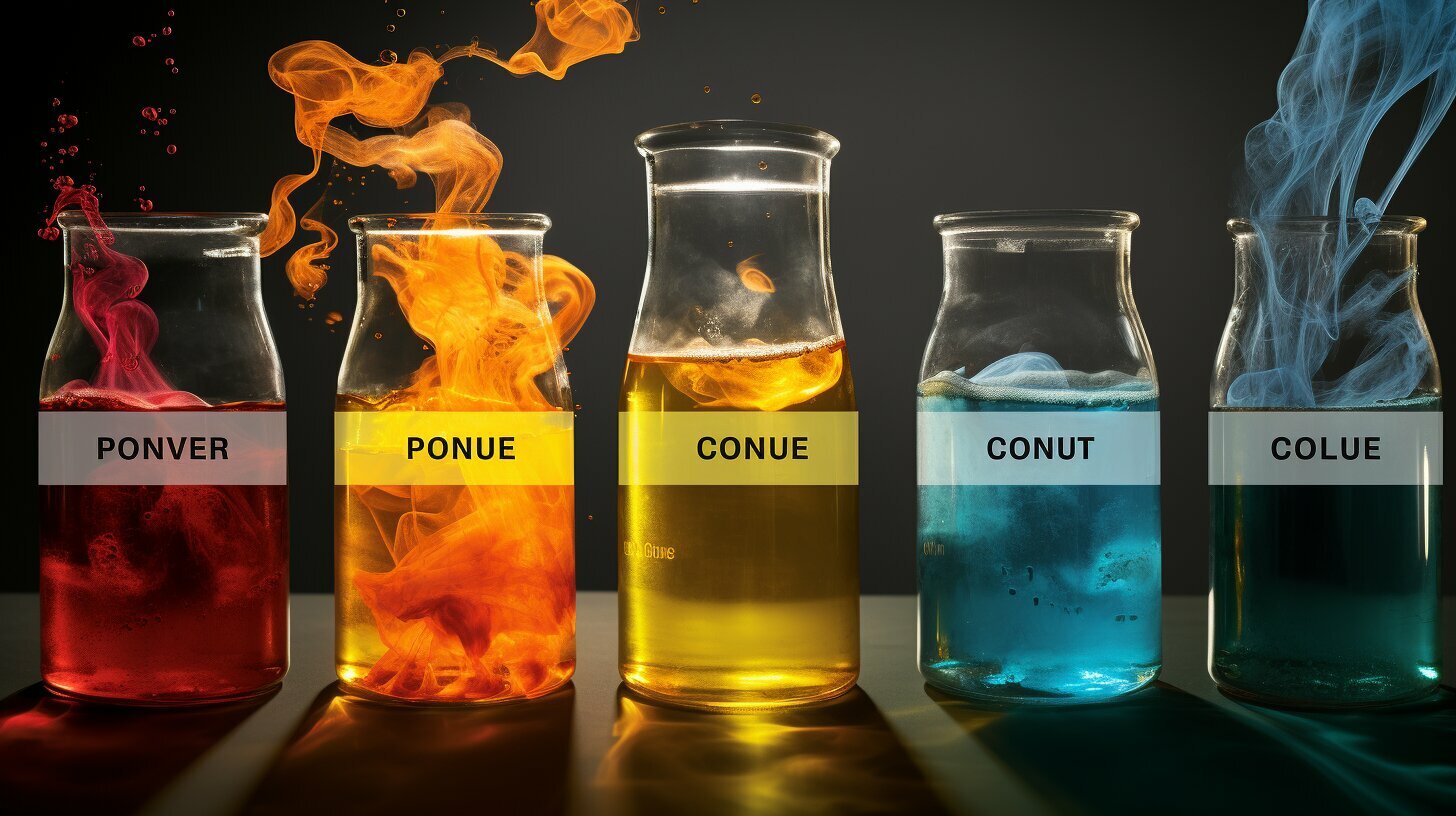Uncovering Why Iodine is Called an Indicator: A Guide
Have you ever wondered why iodine is called an indicator and how it plays a crucial role in chemical reactions? Iodine is known as an indicator because it can react chemically with different substances in characteristic ways. When iodine solution is added to baking soda, it stays light brown, but when added to cornstarch, it turns a very dark purple. This color change indicates a chemical change has occurred. It is this property of iodine that makes it a valuable tool in scientific experiments and investigations.
Key Takeaways:
- Iodine is called an indicator due to its ability to react chemically with different substances, leading to characteristic color changes.
- When iodine solution is added to baking soda, it remains light brown, but when added to cornstarch, it turns a very dark purple.
- These color changes indicate the occurrence of a chemical change.
- Iodine is an essential component of thyroid hormones, playing a crucial role in proper thyroid function and development.
- Food sources such as seaweed, fish, eggs, and dairy products contain iodine.
Understanding Chemical Indicators and Their Properties
Chemical indicators, such as iodine, serve as powerful tools in chemistry due to their distinctive properties and ability to undergo color changes when exposed to certain substances. Iodine, specifically, is commonly used as an indicator due to its unique characteristics.
One of the key properties of iodine as an indicator is its ability to form complex molecules when it reacts with other substances. These complex molecules exhibit different colors, allowing scientists and students to visually identify the presence of certain chemicals or the occurrence of chemical reactions.
When iodine solution is added to baking soda, it remains light brown, indicating that no significant chemical reaction has taken place. However, when iodine solution is added to cornstarch, it undergoes a profound color change, turning a very dark purple. This dramatic shift in color is a clear indication of a chemical change.
Observing Color Changes
By conducting simple tests with different powders and test solutions, students can observe and document the characteristic color changes exhibited by iodine and other chemical indicators. This hands-on approach not only helps in understanding the properties of iodine as an indicator but also fosters a deeper comprehension of chemical reactions and their visual cues.
| Substance | Color Change with Iodine |
|---|---|
| Baking Soda | Remains light brown |
| Cornstarch | Turns very dark purple |
Understanding the properties of iodine as an indicator is not only relevant in educational settings but also has broader implications. Iodine is an essential component of thyroid hormones, which are critical for proper thyroid function and development in the human body. It can be found in various food sources, including seaweed, fish, eggs, and dairy products.
To ensure adequate iodine intake and prevent iodine deficiency, many countries have implemented salt iodization programs. These programs involve adding iodine to table salt, making it an effective and easily accessible source of this essential nutrient. By understanding the role of iodine in the body and the importance of its indicators in chemistry, we can appreciate its significance in both scientific and human health contexts.
Iodine Solution as an Indicator: Unveiling its Behavior in Reactions
When iodine solution is used as an indicator, its unique properties come to light through striking color changes, providing valuable insights into the chemical reactions taking place. These color changes occur due to the chemical reaction between iodine and the substances being tested. One such example is when iodine solution is added to baking soda. In this case, the solution retains its light brown color, indicating that no significant chemical change has occurred. However, when iodine solution is added to cornstarch, it undergoes a dramatic transformation, turning a deep purple. This color change signals the occurrence of a chemical reaction.
In educational activities, iodine solution is often used to test different powders and solutions. This allows students to observe and compare the characteristic color changes that occur when iodine reacts with various substances. This hands-on approach helps deepen their understanding of chemical reactions and the role of indicators.
Aside from its use as an indicator, iodine also plays a crucial role in the human body. It is an essential component of thyroid hormones, which are responsible for regulating metabolism and supporting proper growth and development. Foods such as seaweed, fish, eggs, and dairy products are rich sources of iodine. In addition, salt iodization programs have been implemented in many countries as a preventive measure against iodine deficiency.
| Use of Iodine Solution as an Indicator | Example |
|---|---|
| Baking Soda | No significant color change (remains light brown) |
| Cornstarch | Turns deep purple |
Understanding the behavior of iodine solution as an indicator allows us to gain insights into the intricate world of chemical reactions. Through its characteristic color changes, iodine provides a visual representation of the underlying processes, making it an invaluable tool in educational settings and scientific research. Moreover, recognizing the role of iodine in the body emphasizes its importance not only in the laboratory but also for our overall health and well-being.
The Role of Iodine in Titration and its Indicative Nature
In titration, iodine serves as a crucial indicator, allowing chemists to accurately determine the endpoint of a reaction and attain precise measurements. This property of iodine is harnessed in the field of analytical chemistry, where titration is a widely used technique for determining the concentration of a substance in a solution. By carefully adding a known volume of iodine solution to the sample solution until the endpoint is reached, chemists can quantify the amount of the analyte present.
One common example of iodine’s role as an indicator in titration is the iodometric method for determining the amount of vitamin C in a solution. Here, iodine is first standardized by titrating it with a solution of known concentration, typically sodium thiosulfate. Once the iodine solution is standardized, it can be used to determine the amount of vitamin C in a sample solution. The endpoint is reached when all the vitamin C in the solution has reacted with the iodine, resulting in a color change from brown to a pale yellow.
To accurately determine the endpoint, chemists often add a starch indicator to the reaction mixture. Starch forms a complex with iodine, resulting in a deep blue color. This color change is highly visible and helps chemists identify when the reaction is complete. By carefully titrating to the point where the blue color disappears, chemists can precisely determine the amount of analyte present in the solution.
| Chemical Reaction | Indicator | Endpoint |
|---|---|---|
| Vitamin C titration | Iodine + Starch | Pale yellow color |
| Thiosulfate titration | Iodine + Starch | Colorless |
Through the use of iodine as an indicator in titration, chemists are able to obtain accurate and precise measurements in their analysis. This enables them to determine the concentration of substances in a solution, which is essential in various industries, including pharmaceuticals, environmental monitoring, and quality control. The reliable and characteristic reactions of iodine make it an indispensable tool in the field of analytical chemistry.
The Iodine and Starch Reaction: A Classic Indicator
The reaction between iodine and starch has long served as a classic indicator, producing a distinct color change that aids in identifying the presence of starch in various substances. When iodine solution comes into contact with starch, it undergoes a chemical reaction that causes the color to shift from its original amber hue to a deep blue or purple. This color change is a result of the formation of a complex between iodine molecules and the starch molecules. The unique molecular structure of starch allows it to easily accommodate the iodine, resulting in the formation of this visually striking reaction.
One of the reasons why the iodine and starch reaction is widely used as an indicator is its sensitivity. Even small amounts of starch can trigger a noticeable color change, making it an effective tool for detecting the presence of starch in various substances. This characteristic has practical applications in industries such as food production, where starch is commonly used as a thickening or binding agent in products like sauces, soups, and dressings.
The iodine and starch reaction is also a popular educational experiment, allowing students to observe and explore chemical reactions. By adding iodine solution to different powders and test solutions, students can witness the distinctive color change that occurs when iodine reacts with starch compared to other substances. This hands-on activity not only engages students in scientific discovery but also helps them understand the concept of indicators and the unique properties of iodine as an indicator.
Table 1: Examples of Color Changes in the Iodine and Starch Reaction
| Substance | Color Change |
|---|---|
| Starch | From amber to deep blue or purple |
| Baking soda | No significant color change (remains light brown) |
| Cornstarch | Turns a very dark purple |
The iodine and starch reaction not only showcases the fascinating chemical properties of iodine but also serves as a valuable tool in various fields. From its applications in industry to its role in educational experiments, this classic indicator continues to captivate and educate individuals about the wonders of chemical reactions.
Iodine as an Essential Component in the Body
Beyond its significance as an indicator, iodine plays a crucial role in the human body, particularly in the production of thyroid hormones and the maintenance of thyroid health. The thyroid gland, located in the front of the neck, relies on iodine to produce hormones that regulate various bodily functions, including metabolism, growth, and development.
Thyroid hormones, namely thyroxine (T4) and triiodothyronine (T3), are synthesized by combining iodine with the amino acid tyrosine. These hormones are then released into the bloodstream, where they travel to different organs and tissues to exert their effects. Proper levels of iodine are essential for the healthy functioning of the thyroid gland and the production of these hormones.
Iodine deficiency can lead to a range of health issues, including goiter, cognitive impairment, and developmental abnormalities. Pregnant women and infants are particularly vulnerable to the effects of iodine deficiency, as iodine plays a crucial role in the development of the fetal brain and nervous system. Therefore, ensuring an adequate intake of iodine through diet or supplementation is crucial for overall health and well-being.
| Food Sources of Iodine |
|---|
| Seaweed |
| Fish |
| Eggs |
| Dairy Products |
Incorporating iodine-rich foods into your diet is an effective way to ensure adequate iodine intake. Seaweed, fish, eggs, and dairy products are all excellent sources of iodine. Additionally, many countries have implemented salt iodization programs, which involve adding iodine to table salt, to help prevent iodine deficiency on a population level.
Take care of your thyroid health
Proper thyroid function is vital for overall health and well-being. If you suspect you have iodine deficiency or are experiencing symptoms such as fatigue, weight gain, or increased sensitivity to cold, it is important to consult with a healthcare professional for proper diagnosis and treatment. They can advise you on the best course of action, which may include iodine supplementation or dietary modifications.
Food Sources and Iodine Deficiency Prevention
To maintain adequate iodine levels, incorporating iodine-rich foods into your diet and supporting salt iodization programs are essential for preventing iodine deficiency.
When it comes to ensuring your body receives enough iodine, there are various food sources to consider. Incorporating these iodine-rich foods into your daily meals can help prevent iodine deficiency and maintain your overall health.
Foods High in Iodine:
| Food | Iodine Content (mcg) |
|---|---|
| Seaweed (Kelp, Nori) | Up to 2000 mcg per gram |
| Fish (Cod, Tuna, Shrimp) | 40-200 mcg per serving |
| Eggs | 24-30 mcg per egg |
| Dairy Products (Milk, Cheese, Yogurt) | 10-100 mcg per serving |
In addition to these iodine-rich foods, supporting salt iodization programs is crucial for preventing iodine deficiency. Salt iodization is a process in which iodine is added to table salt, ensuring that individuals consuming salt have a reliable source of this essential mineral. Many countries have implemented salt iodization programs to address iodine deficiency and protect public health.
By incorporating iodine-rich foods into your diet and supporting salt iodization programs, you can help prevent iodine deficiency and maintain optimal thyroid function. Remember to consult with a healthcare professional to determine your specific iodine needs and ensure a balanced diet.
Conclusion
In conclusion, iodine’s distinctive properties make it a valuable indicator in chemical reactions, while also playing a crucial role in the functioning and development of the human body.
As an indicator, iodine can react chemically with different substances in characteristic ways, resulting in distinct color changes. For example, when iodine solution is added to baking soda, it retains a light brown color, but when added to cornstarch, it turns a deep purple. These color changes indicate that a chemical reaction has occurred, making iodine an effective tool for observing and studying chemical transformations.
Furthermore, iodine is an essential component of thyroid hormones, which are responsible for regulating metabolism and promoting healthy growth and development. Without sufficient iodine, the thyroid gland cannot produce enough of these hormones, leading to a range of health issues, including goiter and intellectual disabilities.
To ensure adequate iodine intake, it is important to include iodine-rich foods in our diet. Seaweed, fish, eggs, and dairy products are all excellent sources of this essential nutrient. In addition, many countries have implemented salt iodization programs, which involve adding iodine to table salt, as a preventive measure to combat iodine deficiency.
Overall, understanding the role of iodine as an indicator in chemical reactions and its significance in maintaining optimal thyroid function and development is crucial. By recognizing the importance of iodine and taking steps to ensure its adequate intake, we can promote both our scientific knowledge and our overall health.
FAQ
What is iodine?
Iodine is a chemical element that is commonly used as an indicator in chemical reactions.
Why is iodine called an indicator?
Iodine is called an indicator because it can react chemically with different substances in characteristic ways, leading to observable color changes.
How does iodine solution react with baking soda?
When iodine solution is added to baking soda, it stays light brown, indicating that no chemical change has occurred.
What happens when iodine solution is added to cornstarch?
When iodine solution is added to cornstarch, it turns a very dark purple, indicating a chemical change has occurred.
How can students observe the characteristic reactions of different substances with iodine?
In educational activities, students can conduct tests with different powders and test solutions to observe their characteristic reactions with iodine.
Apart from being an indicator, what other role does iodine play?
Iodine is also an essential component of thyroid hormones and is required for proper thyroid function and development in the body.
Where can iodine be found in food sources?
Iodine can be found in foods such as seaweed, fish, eggs, and dairy products.
How is iodine deficiency prevented?
Salt iodization programs have been implemented in many countries to prevent iodine deficiency.






